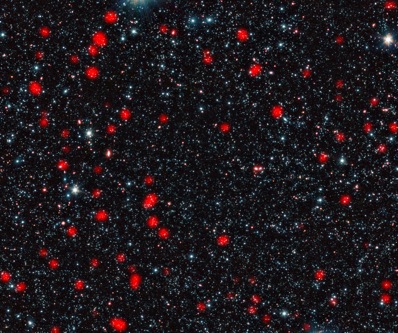
Black holes buzz-kill star formation parties
GEMMA LAVENDER
ASTRONOMY NOW
Posted: 29 January 2012


The most massive galaxies today partied hard and lived fast lives in their younger days, forming stars at an incredible rate for a short time before feedback from black holes shut them down, according to new observations from the Atacama Pathfinder Experiment (APEX) sub-millimetre telescope along with the European Southern Observatory’s Very Large Telescope and NASA’s Spitzer Space Telescope.

The LABOCA camera on the ESO-operated 12-metre Atacama Pathfinder Experiment (APEX) telescope reveals distant galaxies undergoing the most intense type of star formation activity known, referred to as a starburst. This image shows these distant galaxies, found in a region of sky known as the Extended Chandra Deep Field South, in the constellation of Fornax (The Furnace). The galaxies seen by LABOCA are shown in red, overlaid on an infrared view of the region as seen by the IRAC camera on the Spitzer Space Telescope. Image: ESO, APEX (MPIfR/ESO/OSO), A. Weiss et al., NASA Spitzer Science Center.
Today, massive elliptical galaxies such as M84 and M87 in Virgo are usually found in the hearts of galaxy clusters to consist of old, red stars and don’t appear to have had any fresh star formation for a long, long time. The new observations show not only when these galaxies formed, but also what stopped them generating new stars.
The Universe is filled by a ‘cosmic web’ of matter and, at the nodes of intersecting filaments, are large haloes of dark matter. “From simulations of the Universe, we can see very clearly that the more massive haloes are more strongly clustered than the less massive haloes,” says Ryan Hickox of Dartmouth College, USA and Durham University in the UK, who led the research team. This matches what his team saw in their observations of galaxies whose light is ten billion years old, which were more tightly clustered the larger the dark matter halo they were in.
“It makes sense that the bigger things would be all clustered together in the densest part of the Universe because the more clustered objects in denser regions grow by merging more and more material,” Hickox tells Astronomy Now. This large degree of clustering also leads to the starbursts that are ripping through the distant galaxies.
“What has caused the starbursts in these galaxies? We don’t know for sure,” says Hickox. “That’s a matter of debate, though I think there is some good evidence that the starbursts are due to galactic collisions.”

A black hole powered jet of electrons and other sub-atomic particles stream from the centre of the galaxy M87 at nearly the speed of light. Image: NASA/The Hubble Heritage Team (STScI/AURA).
These galaxy mergers are the key to understanding the giant galaxies of today. As galaxies collide, interact and merge they generate a tsunami of star formation that ripples across their gaseous extent, allowing the galaxies to double their number of stars in just 100 million years. A collision between two disc galaxies eventually creates an elliptical galaxy, much like M87. “When they slam into each other the orbits get all scrambled up and you end up with something that looks no longer like a disc but a more spherical or elliptical galaxy where the stars have random orientations,” says Hickox.
After 100 million years, however, star formation simply shuts down. But why? The answer came when the research team compared the distribution of the clustered starburst galaxies with quasars – galaxies with highly energetic black holes. The most extreme galactic collisions in the early Universe succeeded in shovelling large amounts of matter down the throat of the supermassive black hole at the centre of each galaxy. The black hole cannot consume all this matter at once and the majority of it settles into an accretion disc millions of degrees hot. Magnetic fields in the accretion disc whip up some of the electrified gas and eject it away from the black hole in jets travelling at a velocity close to the speed of light. When we look down the jets of these galaxies, we see a quasar.
Hickox’s team found that the distribution of the clustered, starbursting galaxies matched the distribution of quasars at the same time, suggesting a link. The idea is that the jet and associated wind of radiation from the quasar succeeds in heating and blowing the majority of the star-forming gas out of the galaxy and into intergalactic space. This ‘feedback’ from the black hole has long been suspected to bring to an end growth in the most massive galaxies, but Hickox’s teams’ results provide vital observational evidence that quasars are linked with bringing about the end of starbursts after just 100 million years.
“We showed was that the star-forming galaxies and quasars are found in the same place,” says Hickox. “That is exactly what you would expect if the quasars are shutting off the star formation and so it seems that quasars are the likely culprit.”
From starbursting disc galaxy to elderly elliptical with a monster black hole at its heart in just 100 million years – as the saying goes, the most massive galaxies lived fast and died young.
|



